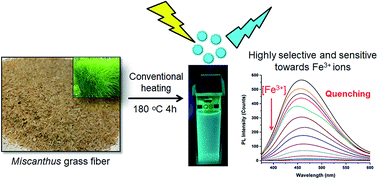Retracted Article: Miscanthus grass-derived carbon dots to selectively detect Fe3+ ions†
Abstract
Novel fluorescent carbon dots (CDs) were synthesized using an economically feasible and green one-step heating process. Miscanthus, a perennial grass and an inexpensive sustainable biomass, was utilized as the starting material to prepare CDs and doped CDs (nitrogen, phosphorous and nitrogen-phosphorous dual doped). The abundance of oxygen-containing functional groups in Miscanthus-derived CDs (MCD) and doped MCD was confirmed via Fourier-transform infrared (FTIR) and energy dispersive X-ray spectroscopy (EDS). The average size of MCD, N-doped MCD, P-doped MCD and dual-doped MCDs was found to be 7.87 ± 0.27, 4.6 ± 0.21, 6.7 ± 0.38 and 5.3 ± 0.32 nm, respectively. The synthesized MCD and doped MCD exhibited a quantum yield (QY) of 4.71, 11.65, 2.33 and 9.63% for the MCD, N-doped MCD, P-doped MCD and dual-doped MCD, respectively. MCD and doped MCD exhibited excellent excitation-dependent photoluminescence properties, with strong blue fluorescence upon irradiation with UV-light (365 nm). N-doped MCD exhibited superb selectivity towards Fe3+ ions, with a detection limit of 20 nM and a detection range from 0.02 to 2000 μM. The normalized linear relationship between the intensity of fluorescence emission of the prepared N-doped MCD and the concentration of Fe3+ ions was utilized to selectively and sensitively detect Fe3+ ions.

- This article is part of the themed collection: Editors’ collection: Fluorescent Sensors


 Please wait while we load your content...
Please wait while we load your content...